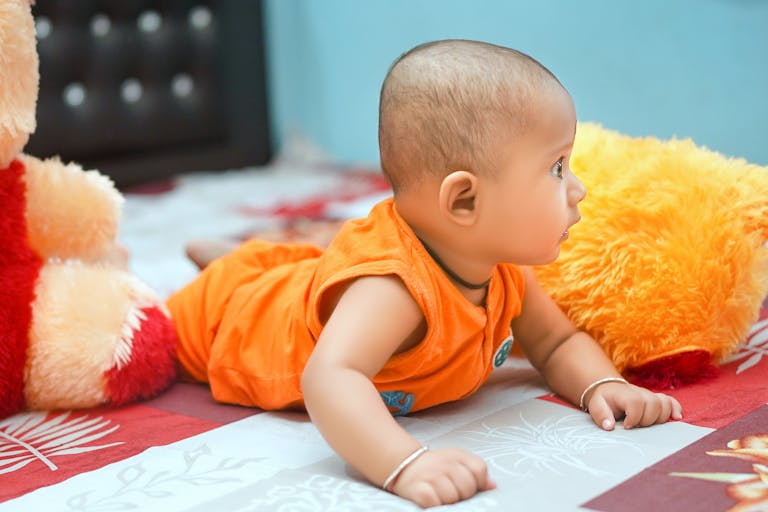Imagine those moments—silent house, your baby wailing for what feels like hours, sleep heavy behind your eyes, patience stretching thin. Every parent, at some point, wonders: Is this endless crying normal? What if nothing soothes? What if, in a second of frustration, something irreversible happens? These questions, though hard to voice, matter deeply. Shaken baby syndrome—also called abusive head trauma—carries a weight that is impossible to ignore. Its very name can spark anxiety, but understanding is often the best protection a parent has. How fragile is your little one’s brain, really? What should you watch for, and where can you turn for help? Let’s unravel the intricate threads of medical facts, everyday challenges, and the very real strategies that shield the most precious people in your world.
What Is Shaken Baby Syndrome? Medical Facts Every Parent Should Know
There’s no drama here—just anatomy, physics, and the delicate architecture of early life. Shaken baby syndrome is a severe injury, rooted in the biology of infancy. Picture this: a baby’s head, large and heavy, balanced atop a neck not yet strong, containing a brain that is still forming. When violently shaken—whether in distress, anger, or desperate fatigue—the head snaps forward and backward. The fragile brain collides against the skull, and tiny blood vessels tear. The result? Subdural hematoma (bleeding inside the brain), retinal hemorrhages (bleeding in the eyes), swelling, and sometimes even spinal cord damage. These injuries aren’t caused by playful bouncing or gentle rocking—only forceful, violent shaking creates this particular storm inside a child’s head.
The numbers are sobering: across global healthcare settings, infants aged two to eight months stand at the highest risk, with cases sometimes observed up to four years. Why? Muscles not yet fully developed, soft skull bones, a brain that isn’t snug in its casing—all combine to make the consequences swift and severe. Preterm babies or those with medical conditions that prompt excessive crying are even more vulnerable.
The Psychology Behind the Crisis: When Fatigue and Frustration Collide
Prolonged crying makes every minute seem longer. Perhaps you’ve felt that heat rise—exhaustion mingled with helplessness. Many episodes of shaken baby syndrome begin in such moments. Fatigue, compounded by isolation, family tension, financial worries, or emotional health challenges (postpartum depression, for example), may push even loving caregivers to the brink. The end result of a fleeting loss of control can, tragically, last a lifetime.
How can parents, grandparents, or babysitters break this dangerous chain? First, by realizing that nearly all babies cry. Once basic needs—hunger, cleanliness, comfort, health—are checked and met, know that bouts of fussiness are, for many families, simply routine. Next, put the baby down safely—on their back, in a crib—and take a step away. Even two minutes apart can settle your nerves without any risk to your baby.
Early Signs: Spotting Symptoms Before It’s Too Late
Symptoms don’t always burst forth dramatically; sometimes, the clues are subtle, almost silent. A child who becomes limp and strangely drowsy, who struggles to breathe, refuses feeds, vomits for no clear reason, or has seizures—each is a red flag. Did you notice a bulging soft spot on the head (fontanelle)? Sudden changes in pupil size? Weakness or loss of movement in one limb? These early signals require immediate medical attention. Sometimes, the first signs arrive days or weeks later—developmental delays, vision issues, or behavioral changes. In all cases, trust your instincts. Seeking emergency medical help quickly can be life-changing.
Medical Examinations and Diagnosis: How Do Doctors Identify Shaken Baby Syndrome?
Information matters as much as science here. The classic diagnostic markers—subdural hematomas and retinal hemorrhages—paint a clear picture, especially when found together. Yet, careful doctors won’t stop there. Some rare genetic, metabolic, or infectious diseases could mimic these injuries, so teams use a blend of physical checks, brain scans (CT scans, MRI), detailed blood tests, and specialized eye exams to determine the cause. Ruling out accidents from everyday falls—those typical tumbles from a low bed or during play—is essential, since routine bumps don’t create deep brain injuries. Multidisciplinary teams—pediatricians, radiologists, neurologists—combine their expertise to reach a sound conclusion. When suspicions run high, social and legal authorities act quickly to keep children safe.
One must distinguish shaken baby syndrome from repeated trauma, sometimes referred to as Silverman syndrome, where bone fractures of various ages hint loudly at chronic abuse.
Consequences: Short-Term and Lifelong Impact
The aftermath of shaken baby syndrome can stretch on for years—or sometimes, heartbreakingly, forever. One in four children may not survive. Survivors often carry the scars: paralysis, learning and cognitive delays, behavior and speech disorders, seizures, blindness, hearing impairment, or even full cerebral palsy. For parents and caregivers, the journey transforms—endless appointments with therapists (physiotherapy, occupational and speech), routine hospital visits, emotional strain, and persistent worry about the future. It isn’t just the child who heals slowly—the family, too, must adapt and grow around these new challenges.
Myths, Misconceptions, and Everyday Realities
Let’s address a few persistent myths. Many wonder—can playful bouncing or joyous rocking cause shaken baby syndrome? The answer: absolutely not. Only violent, intentional shaking can trigger the combination of brain and eye injuries seen in these children. Some believe the so-called diagnostic “triad” (brain bleed, retinal bleeding, and altered consciousness) always points to intentional abuse, but science cautions us to be thorough; other, rare conditions can produce similar findings. Nevertheless, accidental short falls (from a sofa or changing table) do not lead to the same devastating consequences.
Preventing Shaken Baby Syndrome: Solutions Parents Can Use Today
What practical steps can shield children from harm? Consider these simple actions:
- Accept that crying is part of normal infancy. After ruling out pain and hunger, most crying spells aren’t a sign of something wrong.
- Lay your baby down safely and step away if you sense anger or fatigue growing.
- Use soothing techniques—gentle swaddling, soft music, a pacifier, low-pitched white noise—or simply leave the room briefly.
- Share caregiving duties. If another adult is present, hand the baby over for a while.
- Seek social support. Trusted relatives, friends, or professional counselors can offer perspective and respite—and sometimes, just listening makes all the difference.
- Stay informed. Community programs and teaching initiatives like the Period of PURPLE Crying help families understand that persistent fussiness will eventually ease.
Above all: Never shake a baby, no matter the situation.
When Emergency Strikes: What To Do If You Suspect Shaken Baby Syndrome
Should the unthinkable occur—your baby is limp, unable to wake, breathing erratically, or seizing—act immediately. Call emergency services without hesitation. Resist the urge to “wake” your baby by shaking or feeding. If you know CPR, begin as needed and await help. At the hospital, expect evaluations ranging from imaging and blood tests to eye exams and sometimes urgent surgery to control swelling or bleeding. Recovery, if possible, depends on swift intervention and ongoing therapy.
Legal and Social Responses: Protection and Responsibility
Healthcare workers, teachers, and any professional in contact with children are required to report suspected abuse. This isn’t just policy—it’s about securing safety for every child. The consequences, both legal and emotional, can reshape families. Recognizing the sensitivity required due to possible overlap with certain rare medical diseases, a thorough and fair evaluation process takes place, ensuring child safety while respecting family rights.
Community Awareness and Support: Building Safer Homes Together
Initiatives such as Shaken Baby Awareness Day and educational campaigns give caregivers the understanding and strength to cope with challenging moments. Training for parents, relatives, childcare staff, and neighbors builds a net of safety beneath every baby. Participating, sharing, and learning—these small actions ripple outwards, nurturing healthier, more resilient families.
Key Takeaways
- Shaken baby syndrome is a severe, preventable injury—born from brief but intense frustration, resolved only by never shaking a child under any circumstances.
- Catching the early signs—drowsiness, vomiting, seizures, poor feeding—requires vigilance and prompt medical attention.
- Prevention is rooted in education, emotional support, and real-world coping tactics for stress and fatigue.
- Long-term consequences can be daunting, but multidisciplinary care, rehabilitation, and community support offer hope for the affected child and family.
- If you’re searching for practical advice or worried about your child’s health, professionals and resources are always available. Explore application Heloa for tailored health questionnaires and personalized tips to support your child’s development.
Questions Parents Ask
Can mild shaking cause shaken baby syndrome?
It might seem harmless—just a little bounce or pat—but any forceful jolt to a baby’s body can upset the delicate balance. Even movements that feel “gentle” in the heat of exhaustion may have unexpected outcomes. Babies are not miniature adults—their brains and blood vessels are uniquely fragile. Everyday motions like bouncing on your knee or rocking for comfort won’t cause injury, but any vigorous shaking—even if it feels moderate—should be completely avoided.
What should I do if I suspect a child has been shaken?
Immediate action is vital. If you suspect a child has been shaken, keep the child calm and still. Do not try home remedies or feed anything by mouth. Rapidly call for emergency services. Early medical intervention can make a huge impact on recovery, and reaching out is never a sign of weakness.
How can I manage frustration or stress to prevent shaken baby syndrome?
The burden of sleepless nights, unrelenting cries—these are realities for many. Whenever you feel close to your limit, place your baby safely in their crib, step into another room, and count your breaths. Maybe a short walk, music, or calling a trusted friend works best. Sharing these struggles, seeking breaks, or even professional help is not just sensible—it’s responsible. Your emotional equilibrium sets the stage for your baby’s well-being too.
Further reading:









